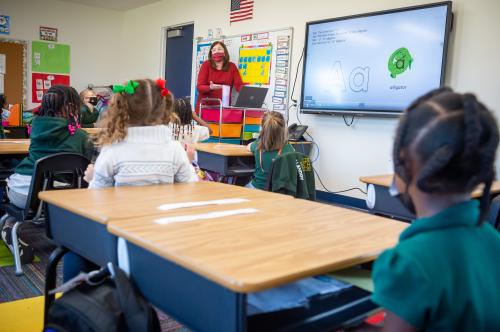Recruiting and retaining high-quality teachers has been a long-standing policy issue as states work to alleviate chronic teacher shortages as well as close achievement gaps. Importantly, evidence points to teacher quality as the most important school-based factor that affects student achievement. Unfortunately, it is often difficult for school and district leadership to identify high-quality teachers who will remain in the classroom, especially among those who are just entering the profession and in the first years of employment.
While the vast majority of teachers in the U.S. enter the profession upon receiving roughly four years of traditional university-based training, research that links preservice teacher experiences to their performance and retention once they are in the labor force is lacking. This overlooks the fact that much of our country’s investment in improving teacher quality happens during teachers’ preservice training. Moreover, recent evidence suggests that the context of a student’s preservice teaching is associated with important consequences for their later employment outcomes.
Our recent study adds to a small but growing body of literature that uses data from teachers’ preservice training to better understand how they fare in the classroom after graduation. We were interested in whether a measure of preservice teacher quality could predict entry and retention in the profession. Our data included over 1,100 graduates of a teacher preparation program housed at a large, state university. In addition to having information collected by the university, we were able to track these graduates’ employment using data from the state department of education. Students enrolled in this program complete a year-long student teaching residency that enables them to enter the labor force with the professional experience of a second-year teacher. During the residency, student teachers receive four formal observations by university-trained coaches who assign them evidence-based scores that are later combined into an overall score of effectiveness. This comprehensive score is based on several indicators including student teachers’ instructional and professional practices. Student teachers are expected to respond to their coach’s feedback after each observation and demonstrate improvement over time. We used the score from preservice teachers’ final assessments as an indicator of overall quality and readiness to enter the profession.
Figures 1 and 2 show that student teachers had different probabilities of entering and staying in the profession depending on their preservice performance scores.[1] For instance, a high-performing student teacher was 7 percentage points more likely to enter the profession compared to a low-performing student teacher. Similarly, among student teachers who were employed upon graduation, a high-performer was 3 percentage points less likely than a low-performer to leave in the first two years of employment. These differences remained stable even after we accounted for a variety of teacher and school characteristics.
Given the observational nature of our data, we cannot argue that preservice teacher quality caused student teachers to enter and remain in the profession. Still, our findings provide some initial evidence that both preparing and recruiting higher-quality preservice teachers into the profession may ultimately help reduce teacher turnover. To this end, teacher preparation programs could benefit from routinely collecting and analyzing data on preservice teachers’ instructional practices. As our study shows, these scores are related to important outcomes like employment and retention, while factors such as demographics and grades prior to student teaching are only weak indicators of preservice teachers’ improvement over time. Observational measures of preservice teachers’ practices, combined with targeted coaching and timely feedback, can be instrumental in teacher preparation programs’ efforts to prepare high-quality teachers who are more likely to enter and stay in the profession. In addition, school districts might use these data on instructional practices to make more informed hiring decisions.
Although our findings offer some initial insight into preservice teacher experiences and labor market outcomes, we believe that our study (and others like it) also emphasize a need to collect and examine more comprehensive data that span teachers’ pre- and in-service careers. Recent research suggests that despite teacher shortages across the country, a significant number of credentialed candidates simply do not enter the profession. While some of these potential candidates likely earned their degrees and chose not to enter the teacher work force, recent data on novice teacher attrition indicates that many of these teachers likely entered the profession and then left shortly after. Although some teacher attrition is natural (such as retirement) and even healthy (when ineffective teachers choose to leave the profession), excessive teacher turnover imposes a financial burden on schools and districts. Further, high amounts of turnover negatively affect student achievement.
To this end, examining more robust data from teachers’ pre- and in-service experiences could prove invaluable. This may be especially useful for schools and school districts as they make hiring decisions. For instance, of the student teachers in our sample who were employed after graduation, roughly 44 percent were hired by a district in which they were a student teacher. While we cannot be certain, it seems likely that many of these districts were able to observe student teachers during their residencies and recruit higher-quality candidates. In many cases, however, this kind of information may not be available to school districts. That said, our study and others like it suggest that collecting, analyzing, and reporting data from teachers’ preservice years shows promise. However, at the moment, those tasked with recruiting and hiring newly-graduated teachers are often left guessing.
Footnote
- Due to data limitations, we were only able to track preservice teacher employment into public schools (district and charter) in the state. Therefore, some teachers who we identify as leaving the profession may have obtained employment in other states or chose to work in private schools.






Commentary
What does preservice teacher quality tell us about entry and retention in the profession?
March 30, 2018